We are not the types to seek out sandy trails when off-roading. The shifting terrain is easy to get stuck in and a headache to get out. Yet, there are vistas, campsites, and other gems only reachable through a patch of troublesome sand. So, in the course of our wanderings, we have had our share of sandy situations and have learned a few tips and tricks when driving on sand.
The key for any sandy drive is to be prepared ahead of time. After all, tow trucks on remote beaches are incredibly expensive. So let us walk you through the key rig features, gear, and techniques to responsibly drive on sand.
Challenges of Driving on Sand
We all know that driving on the sand is tough. But it is tough for several reasons. And understanding what makes sand difficult can help inform how minimize the risk of getting stuck and how to self recover.
- Reduced traction: Sand, especially loose, dry sand, offers significantly less traction compared to solid surfaces like asphalt or gravel. This makes it harder for our tires to grip the surface, which can lead to wheelspin and loss of control.
- Shifting terrain: Sand is constantly shifting under the weight of our vehicle, making it an unpredictable and unstable driving surface. This can cause our vehicle to sink or become stuck, particularly if we stop or slow down abruptly.
- Resistance: The soft, granular nature of sand creates greater resistance against our tires, requiring more power and torque to maintain forward momentum.
There are many ways to mitigate the risks inherent in driving on the sand. We brake them down into three main categories: rig features, gear, and technique.
Features of a Desirable Rig
To begin, a journey across sand is either easier or more difficult based on the rig we are driving. Think about the dune buggy. It is designed with one use in mind: to travel over loose dry sand. It is incredibly light weight with massive, knobby tires. The design maximizes traction on the loose ground and minimizes inertia that could lead to our tires digging a hole in the sand rather than moving forward on the sand.
We are talking about trucks, however. Trucks, and other vehicles are built to meet rigorous road, efficiency, and safety standards. The steal frames and enclosed cabs that makes these rigs suitable for highways conditions also make the rigs less suitable for shifting sand. Even so, there are still characteristics in a standard vehicle that can make them better suited for beach driving:
- Light weight
- Knobby tires
- 4-wheel drive
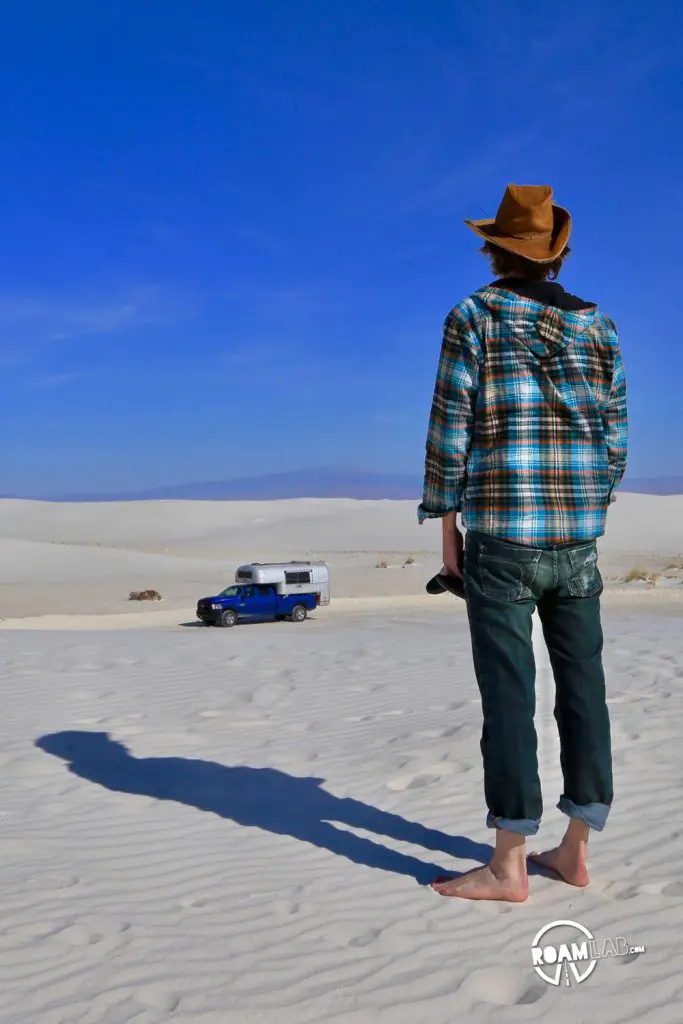
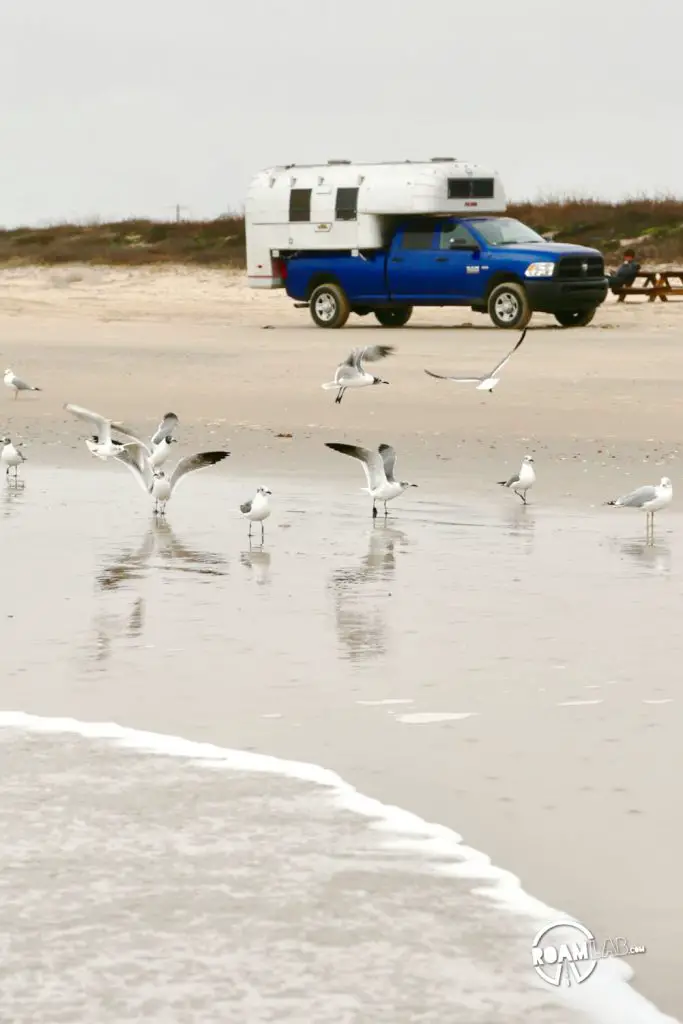
Optimize Your Current Rig
Having addressed what makes and ideal rig, let’s talk about the realities of making due with the vehicle you have. Unless you collect multiple vehicles, it’s unlikely that you have a specialty rig for driving over sand. Fortunately there are a few quick fixes we can do improve your rig’s performance on sand.
All Terrain Tires
The first time we drove on sand was with our factory tires, which were road tires. These are tires designed for road efficiency. They have just enough traction to safely navigate pavement without creating unnecessary friction with overly grippy treads. These are great for your average commute. But nearly had us stuck in a deep patch of sand.
If our vehicle is intended as a mixed use vehicle, our next set of tires should probably be all-terrain. All-terrain tires balance between road efficiency and trail traction and wear. While there are even more specialized tires to tackle sand, all terrains at least will help with traction without getting too noisy on the highways.
Air down your tires
High pressure tires are optimal for highway driving. They maximize gas efficiency by minimizing friction. When you are on the sand, however, that friction is very desirable. Airing down your tires allows you to maximize your tread and also minimize any risk of puncture from the occasional sharp rock. Of course, how much you should air down depends on your tires, rims, rig, and load. We have encountered individuals who have aired their tires down anywhere between 40 and 15 psi.
Granted, it’s worth remembering that whatever air is released while on the sand will have to be replaced soon after. For those traveling with air-compressors, this really is just a matter of time. For us, without an air compressor, it means we won’t be able to air up until we reach our next gas station. So, we are very conservative and only air down to 50 psi.
Keep Your Rig Light
If you are anticipating a sandy adventure, the lighter your rig is, the less pressure and inertia your tires will be fighting against. So, it pays to not carry more weight than is needed. Granted, we travel with everything on the truck, so there isn’t really an opportunity for us to lighten the load. So, we rely on other practicalities.
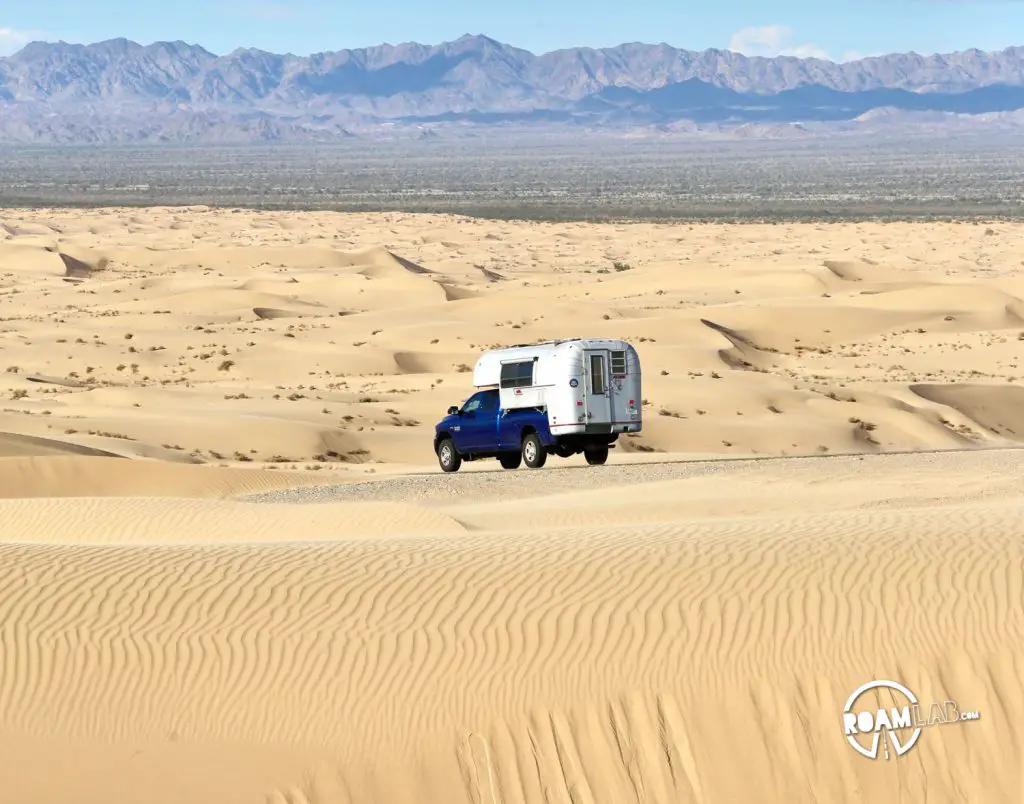
Driving Techniques In Sand
Of course, even the best rig can get stuck in sand if you aren’t careful. So it’s still important to be aware of your environment and be technically aware of your route before you are surprised by an impassible strip of sand.
Avoid Deep Sand
Avoid deep sand when possible. The more the sand has been loosened and turned over onto a deep, soft depression, the easier it will be for your tires to dig into the ground and become struck.
Keep A Steady Speed
We do a lot of starting and stopping while in sand to get the lay of the land. But when the sand is deep, sometimes, it’s only momentum that can propel you through those stretches. At such a time, build up momentum where the ground is more solid and take the deep sand as directly as possible to minimize any turns were you can loose momentum.
Avoid Steep Inclines
The steeper the incline, the more we have to fight the sand to gain ground. Even normally easy slopes can be a problem when sand is in play. When we have to gain elevation, we prioritize routes that draw out the process over a relatively long and subtle slopes. Keep in mind that a steep decline can strand you if there is no gradual incline for your return trip.
Avoid Sharp turns
This nearly stranded us in Texas. We are driving on a dirt road near a Gulf beach and don’t realize we are heading onto sand until we already roll into a deep patch. Worried that our condition will only get worse ahead, we attempt to turn around. Turning our tires for a multipoint turn to get back on the dirt road only serves to dig us progressively deeper and deeper into the sand. Fortunately, when we finally give up any attempt to turn around, we have gravity on our side. We roll strait down to the waterline where the sand is firmer, and follow the shore until we can find an easier exit.
Scout Out Your Route
On one of our trips, we drive to our camp site with relatively little trouble. Yet, when the time comes to leave the next day, we find other cars are parked along the route we had taken to get in place. To leave, we need to take a different, and much more sandy route. Knowing that we already have a lot going against us—deep sand and an incline—we decide that our best bet is to walk the proposed route first and check for any dangerous points. We note where the sand is most solid, where we can gain momentum before tackling the deeper and looser sand. Once we agree on a route, I walk ahead to mark the route while Chris drives behind me.

Rescue Equipment
In the unfortunate case where your wheels dig you into a hole, there are several options. For many, this is the point where a tow truck is called…an extra expensive tow truck. Before making that call, though, there’s a few alternate options.
Traction Boards / Matts
Your core problem with sand is traction. Your tire is trying to find a firm purchase in a shifting terrain. While the sand clearly isn’t providing the needed traction, you can introduce your own. Many overlanders will travel with a set of traction boards or matts, which can be dug under the wheels in cases of sand, mud, and snow.
While these sets are handy, many casual off-roaders don’t travel with these. But what most of us do have are floor mats. Yes, floor mats are built to be durable sources of traction for your feet and can be a handy backup for your tires as well. (Other’s have used old throw rugs and other tough materials they may have with them.) . I wouldn’t call this an alternative so much as a fallback for those occasional surprises.
Long Handled Shovel
Once you are stuck, you will likely need to dig out around the tires to introduce some traction. In such cases, a long handled shovel will make a world of difference. While there are very fancy options sold at many an overlanding outfitter, your garden variety shovel bought at a home improvement store should fit the bill.
Jack & Support
Incase you need to lift your vehicle and access your tires, it’s important to not only have a jack rated for the weight of your rig but also some form of support that can keep the jack from simply sinking into the sand. This can be as simple as a 1’x1’x3/4″ piece of plywood so long as it can spread out the weight of your rig across the sand.
Kinetic Rope
In cases where you cannot rescue your self, another vehicle on firmer ground or with better traction can pull your rig out, provided that you have rope properly rated for your rig’s weight. So, be sure to have your own rope incase you need to ask for a little tow.
A Few Other Handy Tools
Digital Tire Deflator
When airing down tires, a digital tire deflator can make the process much faster and strait forward. At the moment, I sit in the driver’s seat and read out the tire pressure reported on the truck’s dash when we are deflating and inflating our tires. A digital tire deflator, however, allows for a much higher degree of accuracy.
Air Compressor
Air compressors serve many functions in off road driving. While they make airing up after airing down much easier, they are also important for filling up a tire in case you need to patch a hole. One piece of advice we’ve definitely found is to not cheap out when it comes to an air compressor. The heavier your rig is, the more pressure you need and a quality air compressor will make all the difference.
Tire Patching Kit
Yeah, it’s just a generally good thing to have when off-roading.
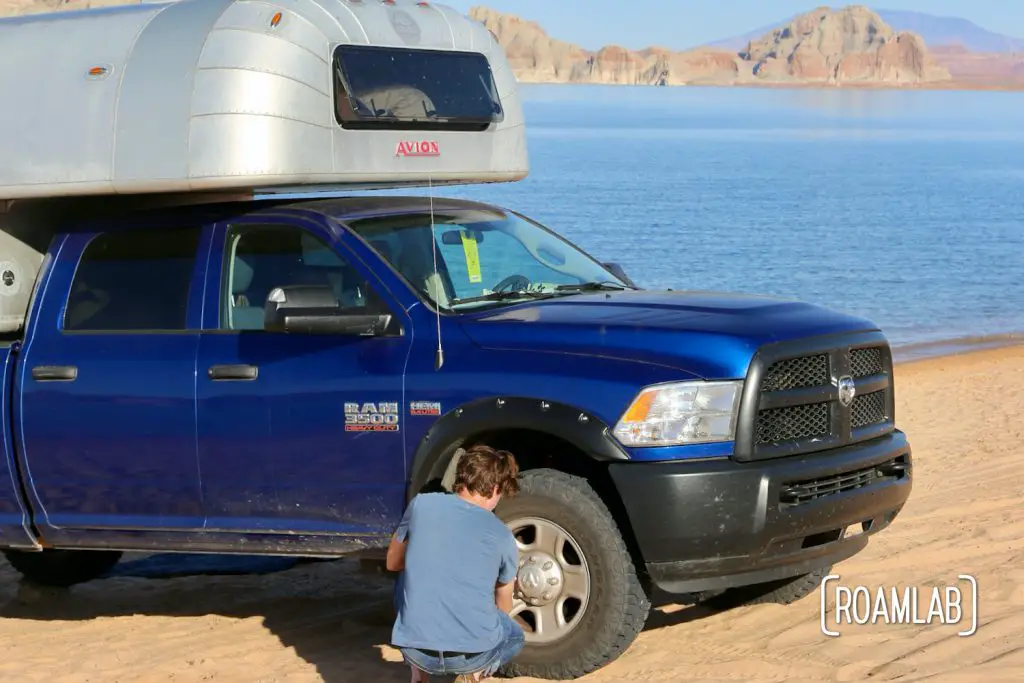
Happy Driving
Finding the right route and learning your rigs limitations is a process. So, don’t drive too far down the beach on your first trip. And make sure people know where you are going and for how long.
Do you have any stories or advice about driving on sand? Share them in the comments!


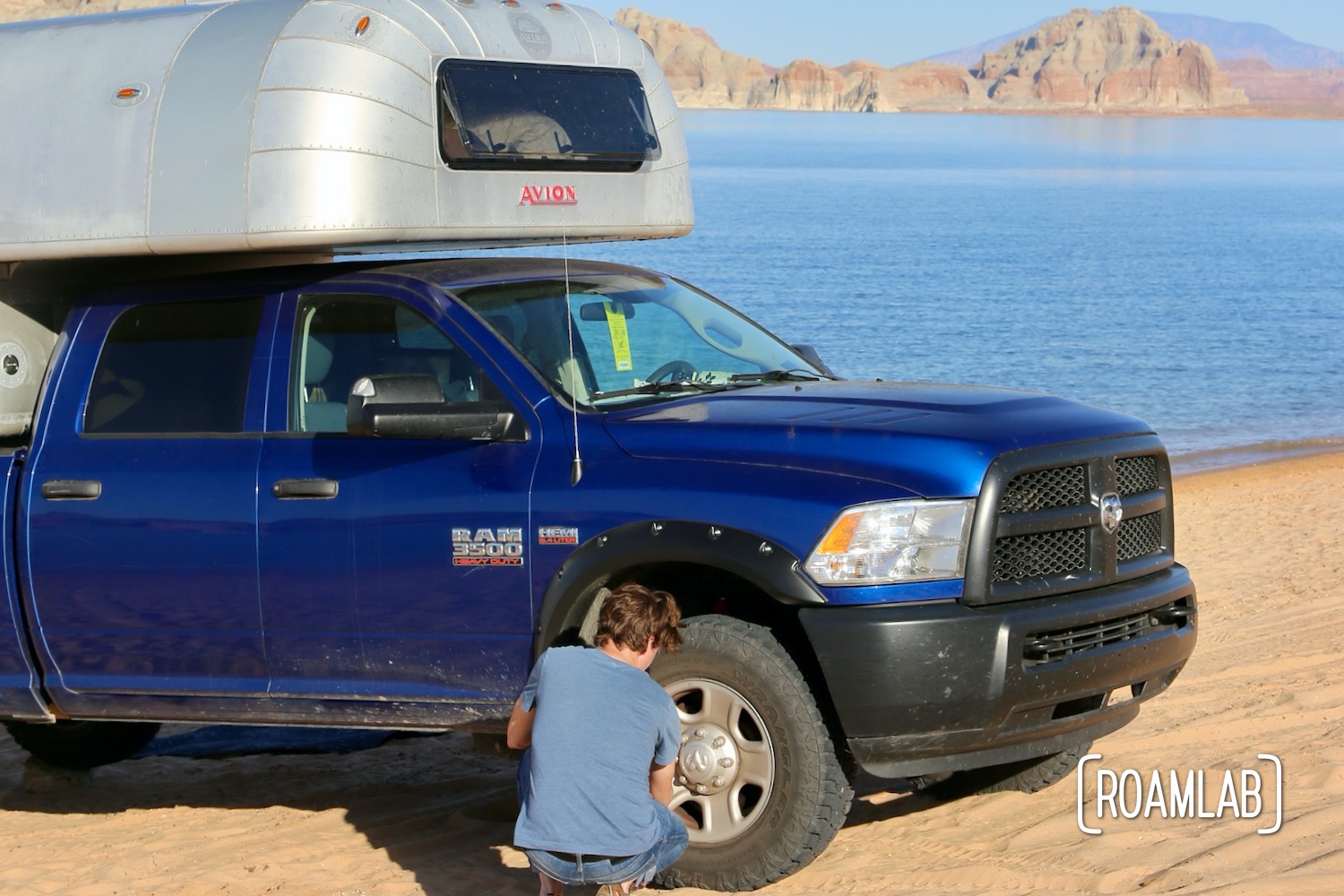

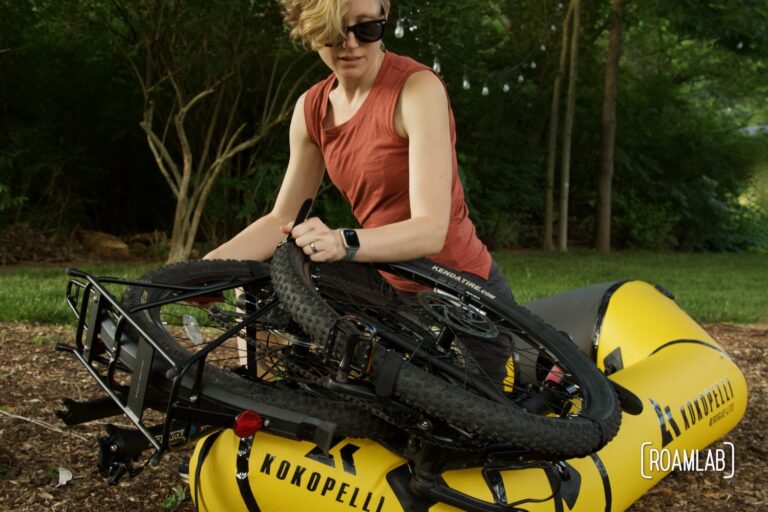

We had to air down our tires to visit Canyon de Chelly National Monument. I don’t recall how much we released, but we didn’t have an air compressor with us so we had to drive a few miles down the highway to get to a gas station to air them up again. We were travelling with an Airstream at the time which we left in the campground.
Canyon de Chelly (pronounced “can-yun duh shay.”) is one of the most impressive places we’ve visited! You are only allowed entry with a guide. A 4WD vehicle is required, and you can either use your own vehicle or hire a guide who can provide one. We didn’t get stuck, but we saw another pickup truck that was stuck.